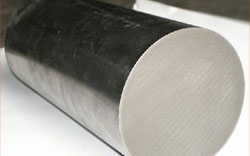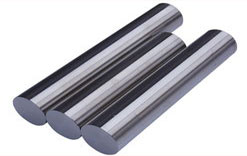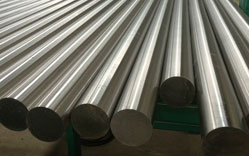
Trade promotes production, production furthers trade
Mission: To be abundant in China, to be beneficial everywhere
Business philosophy: Survive by quality, develop on creativity
Dream: Struggle for astronautics of humankind
Service philosophy: Is it not delightful to have friends coming from afar



|
Grade |
Specifications |
Surface |
Standard |
|
R60702 |
Dia 5-300mm |
Polished |
ASTM B550/B550M-07 |
|
R60704 | |||
|
R60705 |
Mechanical properties
|
Mechanical properties |
Grades | ||
|
R60702 |
R60704 |
R60705 | |
|
Tensile strength |
55{380} |
60{415} |
80{550} |
|
Yield strength |
30{205} |
35{240} |
55{390} |
|
Elongation |
16 |
14 |
16 |
Zirconium is a chemical element with the symbol Zr, atomic number 40 and atomic mass of 91.224. The name of zirconium is taken from the mineral zircon, the most important source of zirconium, and from the Persian word "zargun", meaning "gold colored". It is a lustrous, grey-white, strong transition metal that resembles titanium. Zirconium is mainly used as a refractory and opacifier, although it is used in small amounts as an alloying agent for its strong resistance to corrosion. Zirconium forms a variety of inorganicand organometallic compounds such as zirconium dioxide and zirconocene dichloride, respectively.
Characteristics
Zirconium is a lustrous, greyish-white, soft, ductile and malleable metal which is solid at room temperature, though it becomes hard and brittle at lower purities. In powder form, zirconium is highly flammable, but the solid form is far less prone to ignition. Zirconium is highly resistant to corrosion by alkalis, acids, salt water and other agents. However, it will dissolve in hydrochloric and sulfuric acid, especially when fluorine is present. Alloys with zinc become magnetic below 35 K.
Zirconium's melting point is 1855 °C (3371 °F), and its boiling point is 4371 °C (7900 °F).Zirconium has an electronegativity of 1.33 on the Pauling scale. Of the elements within d-block, zirconium has the fourth lowest electronegativity after yttrium, lutetium and hafnium.
At room temperature zirconium exhibits a hexagonally close packed crystal structure, α-Zr, which changes to β-Zr a body-centered cubic crystal structure at 863 °C. Zirconium exists in the β-phase until the melting point.
Applications
Compounds
The great majority of zircon is used directly in a variety of high temperature applications. This material is refractory and hard, as well as resistant to chemical attack. Because of these properties, zircon finds many applications, few of which are highly publicized. Its main use is as an opacifier, conferring a white, opaque appearance to ceramic materials. Because of its chemical resistance, zircon is also used in aggressive environments, such as moulds for molten metals. Zirconium dioxide (ZrO2) is used in laboratory crucibles, metallurgical furnaces, as a refractory material, and it can be sintered into a ceramic knife. Zircon (ZrSiO4) is cut into gemstones for use in jewellery.
Metal
A small fraction of the zircon is converted to the metal, which finds various niche applications. Because of zirconium's excellent resistance to corrosion, it is often used as an alloying agent in materials that are exposed to aggressive environments, such as surgical appliances, light filaments and watch cases. The high reactivity of zirconium toward oxygen, apparent only at high temperatures, is the basis of some specialised applications as explosive primers and as getters in vacuum tubes. The same behavior is probably the basis of the use of Zr nano-particles aspyrophoric material in explosive weapons such as the BLU-97/B Combined Effects Bomb for incendiary effect.
Nuclear applications
Cladding for nuclear reactor fuels consumes about 1% of the zirconium supply. For this purpose, it is mainly used in the form of zircaloys. The benefits of Zr alloys is their low neutron-capture cross-section and good resistance to corrosion under normal service conditions. The development of efficient methods for the separation of zirconium from hafnium was required for this application.
One disadvantage of zirconium alloys is their reactivity toward water at high temperatures leading to the formation of hydrogen gas and to the accelerated degradation of the fuel rod cladding:
Zr + 2 H2O → ZrO2 + 2 H2
This exothermic reaction is very slow below 100 °C, but at temperature above 900 °C the reaction is rapid. Most metals undergo similar reactions. The redox reaction is relevant to the instability of fuel assemblies at high temperatures. This reaction was responsible for a small hydrogen explosion first observed inside the reactor building of Three Mile Island nuclear power plant in 1979, but then, the containment building was not damaged. The same reaction occurred in the reactors 1, 2 and 3 of the Fukushima I Nuclear Power Plant (Japan) after the reactors cooling was interrupted by the earthquake and tsunami disaster of March 11, 2011 leading to the Fukushima I nuclear accidents. After venting of hydrogen in the maintenance hall of these three reactors, the explosive mixture of hydrogen with air oxygen detonated, severely damaging the installations and at least one of the containment buildings. To avoid explosion, the direct venting of hydrogen to the open atmosphere would have been a preferred design option. Now, to prevent the risk of explosion in many pressurized water reactor (PWR) containment buildings, a catalyst-based recombinator is installed to rapidly convert hydrogen and oxygen into water at room temperature before the explosivity limit is reached.
Space and aeronautic industries
Materials fabricated from zirconium metal and its oxide (ZrO2) are used in space vehicle parts for their resistance to heat. Zirconia is also a component in some abrasives, such as grinding wheels and sandpaper.
High temperature parts such as combustors, blades and vanes in jet engines and stationary gas turbines are to an increasing extent being protected by thin ceramic layers. These ceramic layers are usually composed by a mixture of zirconia and yttria.
please
Call: +86-(0)917-3565328
No.195 Gaoxin Road
Titinum Valley Building
Baoji Hi-tech Zone
Shaanxi province, China
